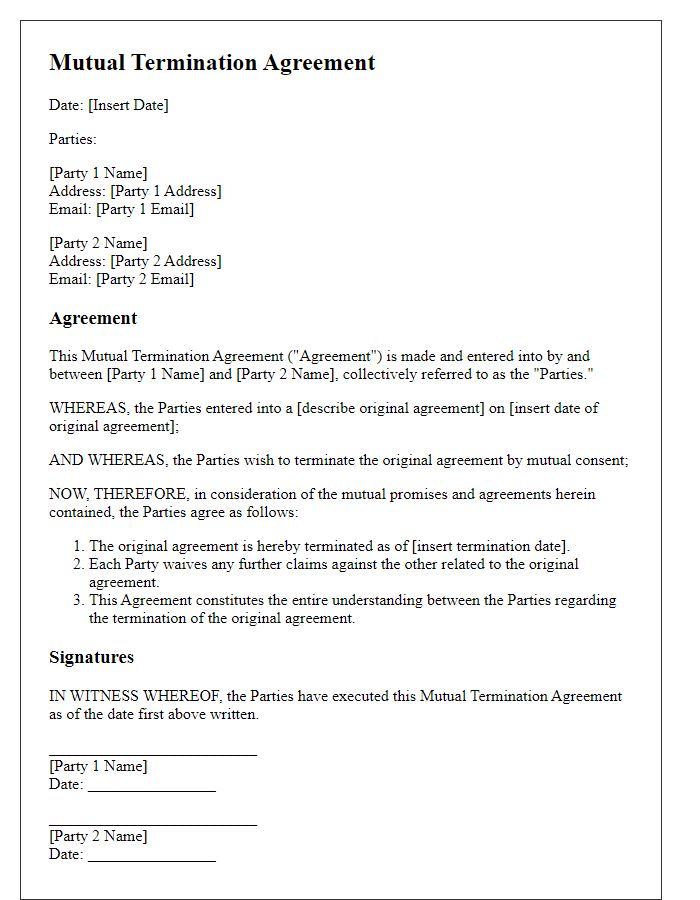When it comes to navigating the often tricky waters of employment termination, having a clear and concise letter template can make all the difference. Whether you're an employer needing to communicate the end of a contract or an employee looking to understand your rights, the proper language is essential. This article will walk you through key elements to include in your termination letter, ensuring that the process remains professional and respectful. So, if you're ready to arm yourself with the right tools for this important task, keep reading to discover our comprehensive guide!

Date and Employee Information
Termination of employment contracts often involves specific details regarding the date and employee information. The effective termination date, typically specified as the last working day, is crucial for both parties. Employee information includes the full name of the employee, employee ID number, position held, department, and dates of employment. Clear documentation is necessary to ensure compliance with legal obligations and organizational policies. Details about any final paycheck, benefits, or severance pay should also be included to provide transparency and maintain clarity during the transition process. Proper communication during this process reduces misunderstandings and fosters professionalism.
Subject Line: Termination Notice
The termination of an employment contract requires careful consideration and adherence to legal protocols. For instance, an employer must provide a formal notice, typically delivered within the stipulated time frame outlined in the employment agreement, often ranging from two weeks to thirty days. The notice should clearly state the reason for termination, which could include performance issues, company restructuring, or other specified breaches. It should also contain the effective termination date, the employee's final paycheck information, and details about accrued benefits such as vacation days or severance pay. This formal communication, usually typed on company letterhead, serves as an official record of the termination, essential for both parties' legal protection and future references.
Reason for Termination
Termination of employment contracts often arises due to a variety of reasons, such as unsatisfactory performance, violations of company policy, or economic downturns. In cases of unsatisfactory performance, employees may fail to meet the established Key Performance Indicators (KPIs) outlined during onboarding. Violations may include unethical behavior, such as breaches of confidentiality, not adhering to workplace standards, or engaging in harassment. Economic downturns can lead to workforce reductions, where companies streamline operations to remain viable. Documented evidence, such as performance reviews or incident reports, typically supports these reasons, ensuring the process adheres to labor laws and minimizes potential legal repercussions.
Effective Termination Date
The effective termination date for an employment contract signifies the final day of an employee's tenure at a company. This date is critical for both parties, marking the conclusion of responsibilities and entitlements. On this date, all company property such as laptops, access cards, and mobile devices must be returned, and final salary payments, including accrued vacation pay or severance, should be processed. Following the effective termination date, the employee may also be entitled to a benefits continuation period under COBRA (Consolidated Omnibus Budget Reconciliation Act), which allows former employees to maintain health coverage for a specified duration. It is essential that the effective termination date be communicated clearly to avoid misunderstandings regarding ongoing obligations or benefits.
Next Steps and Final Compensation
Termination of an employment contract involves several critical details. After notifying the employee about the decision, it is essential to outline next steps clearly. This includes the final working day, which might be in accordance with the notice period specified in the contract, often 30 days for a standard agreement. Final compensation details need to be included, specifying the calculation of any outstanding wages, including accrued vacation days, sick leave payouts, or overtime pay, all of which must be compliant with local labor laws such as the Fair Labor Standards Act in the United States. Furthermore, any additional benefits, such as severance pay or health insurance options, should also be highlighted, clearly indicating timelines for the disbursement of these payments. It is crucial to ensure that all terms reflect the company's policies, and measures should be taken to support the employee during the transition, thereby fostering goodwill even in a challenging situation.
Letter Template For Termination Of Employment Contract Samples
Letter template of termination of employment due to company restructuring













Comments